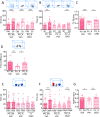Chemogenetic rectification of the inhibitory tone onto hippocampal neurons reverts autistic-like traits and normalizes local expression of estrogen receptors in the Ambra1+/- mouse model of female autism
- PMID: 36804922
- PMCID: PMC9941573
- DOI: 10.1038/s41398-023-02357-x
Chemogenetic rectification of the inhibitory tone onto hippocampal neurons reverts autistic-like traits and normalizes local expression of estrogen receptors in the Ambra1+/- mouse model of female autism
Abstract
Female, but not male, mice with haploinsufficiency for the proautophagic Ambra1 gene show an autistic-like phenotype associated with hippocampal circuits dysfunctions which include loss of parvalbuminergic interneurons (PV-IN), decrease in the inhibition/excitation ratio, and abundance of immature dendritic spines on CA1 pyramidal neurons. Given the paucity of data relating to female autism, we exploit the Ambra1+/- female model to investigate whether rectifying the inhibitory input onto hippocampal principal neurons (PN) rescues their ASD-like phenotype at both the systems and circuits level. Moreover, being the autistic phenotype exclusively observed in the female mice, we control the effect of the mutation and treatment on hippocampal expression of estrogen receptors (ER). Here we show that excitatory DREADDs injected in PV_Cre Ambra1+/- females augment the inhibitory input onto CA1 principal neurons (PN), rescue their social and attentional impairments, and normalize dendritic spine abnormalities and ER expression in the hippocampus. By providing the first evidence that hippocampal excitability jointly controls autistic-like traits and ER in a model of female autism, our findings identify an autophagy deficiency-related mechanism of hippocampal neural and hormonal dysregulation which opens novel perspectives for treatments specifically designed for autistic females.
© 2023. The Author(s).
Conflict of interest statement
The authors declare no competing interests.
Figures





References
-
- Ajram LA, Pereira AC, Durieux AMS, Velthius HE, Petrinovic MM, McAlonan GM. The contribution of [1H] magnetic resonance spectroscopy to the study of excitation-inhibition in autism. Prog Neuropsychopharmacol Biol Psychiatry. 2019;89:236–44. - PubMed
-
- Lee E, Lee J, Kim E. Excitation/Inhibition imbalance in animal models of Autism Spectrum Disorders. Biol Psychiatry. 2017;81:838–47. - PubMed
Publication types
MeSH terms
Substances
LinkOut - more resources
Full Text Sources
Molecular Biology Databases
Miscellaneous

